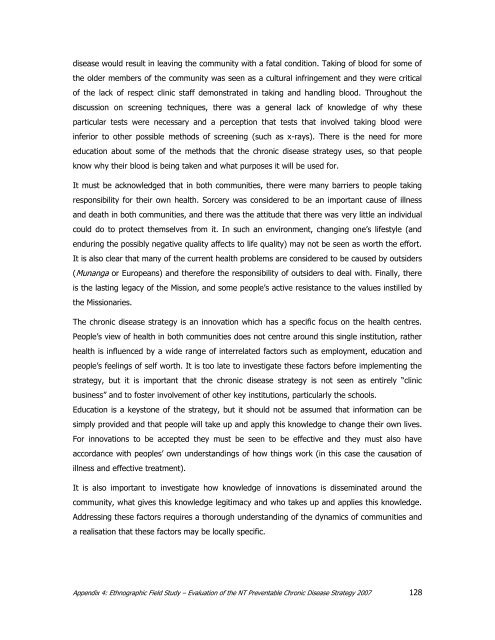PCD Strategy Evaluation 2007.pdf - NT Health Digital Library ...
PCD Strategy Evaluation 2007.pdf - NT Health Digital Library ...
PCD Strategy Evaluation 2007.pdf - NT Health Digital Library ...
Create successful ePaper yourself
Turn your PDF publications into a flip-book with our unique Google optimized e-Paper software.
disease would result in leaving the community with a fatal condition. Taking of blood for some ofthe older members of the community was seen as a cultural infringement and they were criticalof the lack of respect clinic staff demonstrated in taking and handling blood. Throughout thediscussion on screening techniques, there was a general lack of knowledge of why theseparticular tests were necessary and a perception that tests that involved taking blood wereinferior to other possible methods of screening (such as x-rays). There is the need for moreeducation about some of the methods that the chronic disease strategy uses, so that peopleknow why their blood is being taken and what purposes it will be used for.It must be acknowledged that in both communities, there were many barriers to people takingresponsibility for their own health. Sorcery was considered to be an important cause of illnessand death in both communities, and there was the attitude that there was very little an individualcould do to protect themselves from it. In such an environment, changing one‟s lifestyle (andenduring the possibly negative quality affects to life quality) may not be seen as worth the effort.It is also clear that many of the current health problems are considered to be caused by outsiders(Munanga or Europeans) and therefore the responsibility of outsiders to deal with. Finally, thereis the lasting legacy of the Mission, and some people‟s active resistance to the values instilled bythe Missionaries.The chronic disease strategy is an innovation which has a specific focus on the health centres.People‟s view of health in both communities does not centre around this single institution, ratherhealth is influenced by a wide range of interrelated factors such as employment, education andpeople‟s feelings of self worth. It is too late to investigate these factors before implementing thestrategy, but it is important that the chronic disease strategy is not seen as entirely “clinicbusiness” and to foster involvement of other key institutions, particularly the schools.Education is a keystone of the strategy, but it should not be assumed that information can besimply provided and that people will take up and apply this knowledge to change their own lives.For innovations to be accepted they must be seen to be effective and they must also haveaccordance with peoples‟ own understandings of how things work (in this case the causation ofillness and effective treatment).It is also important to investigate how knowledge of innovations is disseminated around thecommunity, what gives this knowledge legitimacy and who takes up and applies this knowledge.Addressing these factors requires a thorough understanding of the dynamics of communities anda realisation that these factors may be locally specific.Appendix 4: Ethnographic Field Study – <strong>Evaluation</strong> of the <strong>NT</strong> Preventable Chronic Disease <strong>Strategy</strong> 2007 128
















